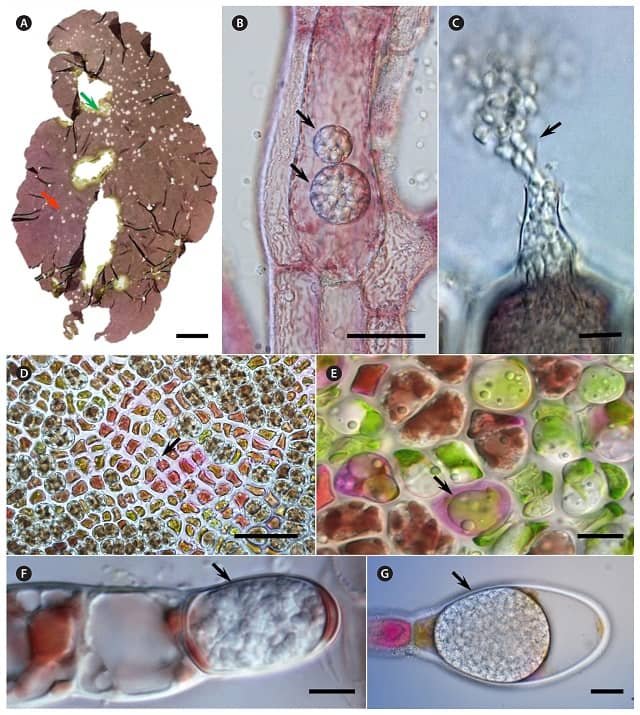
The thriving red seaweed aquaculture industry faces a hidden enemy: oomycete pathogens. These microscopic predators threaten to decimate seaweed crops, endangering both the production of these macroalgae and the associated environmental benefits.
To develop effective control measures, understanding the cellular and molecular mechanisms of host-pathogen interactions in red algae is crucial to ensure that seaweed aquaculture continues to provide bioactive compounds.
A scientific review, published by researchers from Kongju National University, Victoria University of Wellington, and Kamchatka State Technical University, compiles a revised list of known oomycete pathogens that infect marine red algae. The study also includes research on the molecular and cellular responses of red algae to oomycete infection.
Little-known foe
Oomycetes are among the most significant pathogens as they can infect a range of algae, plants, and animals. Several pathogenic oomycetes are responsible for destruction and losses in agriculture and aquaculture.
The fight against oomycetes is hindered by a lack of knowledge. Research on their spread, algae defense mechanisms, and even their proper classification is shrouded in uncertainty. In notorious genera such as Pythium and Olpidiopsis, existing classifications based on morphology often contradict molecular evidence.
On the other hand, researchers have identified seven species of oomycetes that infect red algae: Eurychasmidium tumefaciens, E. sacculum (formerly known as Eurychasma sacculus), Sirolpidium andreei (formerly known as Olpidiopsis andreei), Petersenia lobata, P. pollagaster, Pontisma lagenidioides, and Pythium marinum. However, only two species, Pyt. marinum and Po. agenidioides, have been taxonomically studied using molecular methods.
Additionally, Badis et al. (2019) described two new oomycete species, Olpidiopsis palmariae and O. muelleri spp., infecting commercial cultivation of red algae Palmaria and Porphyra in Europe. Badis et al. (2020) reported that Pythium porphyrae, causing red rot disease, is responsible for devastating outbreaks in Pyropia macroalgae farms.
Red algae defense against pathogenic oomycetes
Red macroalgae exhibit a diversity of immune responses to pathogen infection.
Recent studies have identified key genes involved in red algae defense, revealing two lines of fortification: Pattern-Triggered Immunity (PTI) and Effector-Triggered Immunity (ETI). PTI acts as a first line of defense, while ETI launches a targeted attack against specific oomycete weapons. Moreover, research suggests that calcium-mediated signaling plays a crucial role in the algae’s immune response.
Oomycete control
Methods for controlling oomycete diseases were developed by seaweed producers in the field, particularly in Pyropia cultivation, and have been industrialized in Asia.
Current control strategies, based on the natural resistance of algae to harsh conditions, are robust tools. Producers inhibit pathogen growth by exposing the nets to air for several hours and letting them dry in sunlight.
Another method is acid washing of cultivation nets to reduce epiphytic green algae, diatoms, and oomycete pathogens. An equipped boat passes beneath the cultivation net, and the net is immersed in an acidic solution as the boat moves slowly.
While these methods are effective, they may have unintended environmental consequences. For example, the acid method has little effect on Olpidiopsis blight and poses an environmental burden.
The study also cites the work of Kim et al. (2023), who used a technology that can effectively control oomycete pathogens by washing aquaculture nets with calcium propionate and is awaiting government review.
The search for sustainable solutions continues, with researchers exploring avenues such as selective breeding, seaweed extracts, and even genetically modified algae.
Conclusion
According to researchers, many questions still need answers to improve understanding of seaweed farm pathogens and how their impacts can be mitigated.
They also emphasize that although some aspects of the innate immunity of Pyropia spp. have been demonstrated after oomycete infection, further research is needed on innate immunity in other red algae for better understanding.
The provided article is a valuable step in unmasking the threat of oomycetes. By compiling a revised list of red algae pathogens, clarifying their taxonomy, and shedding light on algae defense mechanisms, pave the way for smarter and more effective management strategies.
The study was conducted by the Marine Fishery Bio-resources Center and funded by the National Marine Biodiversity Institute of Korea (MABIK) and the National Research Foundation of Korea (NRF).
Contacto
Gwang Hoon Kim
Department of Biological Sciences
Kongju National University
Gongju 32588, Korea
Tel: +82-41-850-8504, Fax: +82-41-850-8479
E-mail: ghkim@kongju.ac.kr
Reference (open access)
Wen, X., Zuccarello, G. C., Klochkova, T. A., & Kim, G. H. (2023). Oomycete pathogens, red algal defense mechanisms and control measures. Algae, 38(4), 203-215.
Other References
Badis, Y., Klochkova, T. A., Strittmatter, M., Garvetto, A., Murúa, P., Sanderson, J. C., … & Gachon, C. M. (2019). Novel species of the oomycete Olpidiopsis potentially threaten European red algal cultivation. Journal of Applied Phycology, 31, 1239-1250.
Badis, Y., Han, J. W., Klochkova, T. A., Gachon, C. M., & Kim, G. H. (2020). The gene repertoire of Pythium porphyrae (Oomycota) suggests an adapted plant pathogen tackling red algae. Algae, 35(2), 133-144.
Kim, Y. T., Kim, R. W., Shim, E., Park, H., Klochkova, T. A., Kim, G. H., … & Kim, G. H. (2023). Control of oomycete pathogens during Pyropia farming and processing using calcium propionate. Algae, 38(1), 71-80.
Editor at the digital magazine AquaHoy. He holds a degree in Aquaculture Biology from the National University of Santa (UNS) and a Master’s degree in Science and Innovation Management from the Polytechnic University of Valencia, with postgraduate diplomas in Business Innovation and Innovation Management. He possesses extensive experience in the aquaculture and fisheries sector, having led the Fisheries Innovation Unit of the National Program for Innovation in Fisheries and Aquaculture (PNIPA). He has served as a senior consultant in technology watch, an innovation project formulator and advisor, and a lecturer at UNS. He is a member of the Peruvian College of Biologists and was recognized by the World Aquaculture Society (WAS) in 2016 for his contribution to aquaculture.
